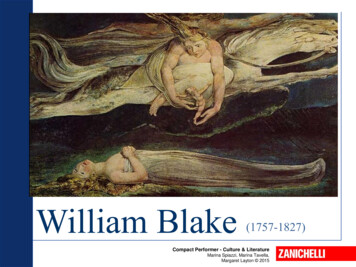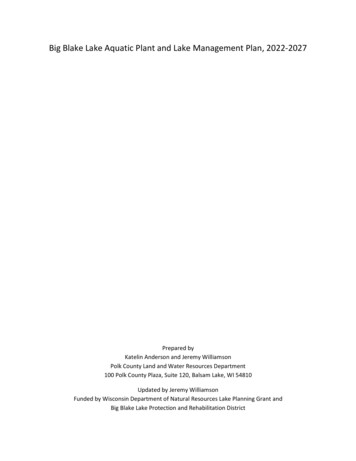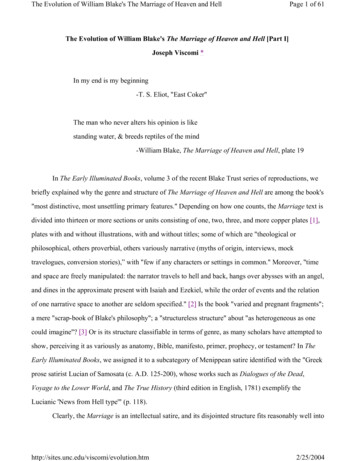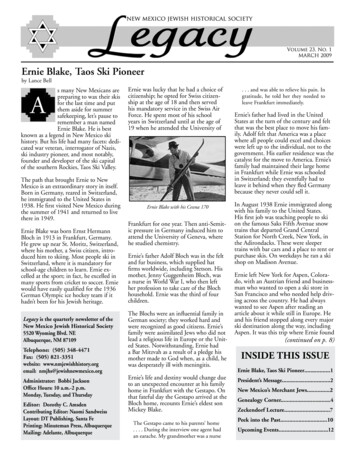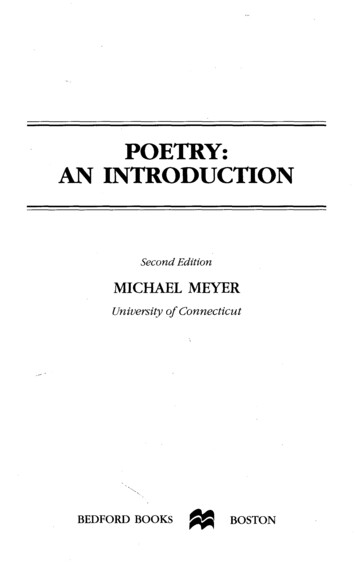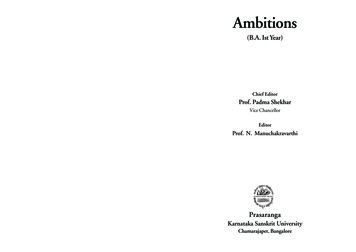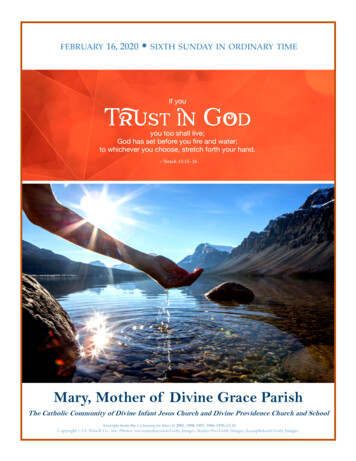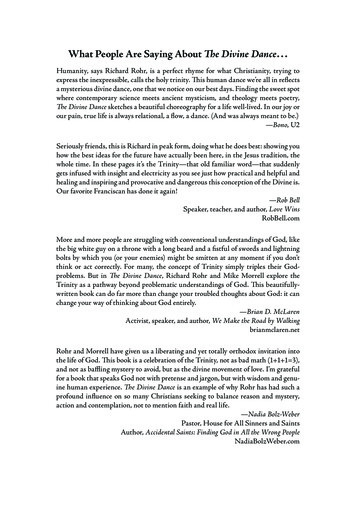
Transcription
7“HUMAN FORMS DIVINE”: WILLIAM BLAKE’STHE RAISING OF JAIRUS’S DAUGHTERElizabeth E. BarkerIntroductionIn December 2011, the Mead Art Museum at Amherst College (Amherst, Massachusetts, USA)received a remarkable gift: The Raising of Jairus’s Daughter, a rare tempera painting by William Blake.The existence of the painting has long been known: Rossetti included it in the first catalogue raisonnéof Blake’s works, published in 1863 (cat. 143, 447). Yet before coming to Amherst, Jairus’s Daughterappears never to have been exhibited in any public venue, including during the artist’s lifetime. Norhas the painting been widely published. Although mentioned in several studies, it has received littleextended attention, and been reproduced only twice before the present instance, in black-and-whiteillustrations whose imperfect quality gives a mistaken impression of poor preservation (Keynes, 34 andButlin, pl. 1193). The acquisition of Jairus’s Daughter by a public museum will surely rectify its formerneglect. This article seeks to begin the process of rediscovery, and to suggest avenues of further enquiry. 1The CommissionBlake painted The Raising of Jairus’s Daughter as part of an extraordinary commission. On 26August 1799, the artist shared the news in a letter to his friend George Cumberland:As to Myself about whom you are so kindly Interested. I live by Miracle. I am Painting smallPictures from the Bible. My Work pleases my employer & I have an order for Fifty smallPictures at One Guinea each which is Something better than mere copying after another artist.(E. 704)Blake’s “employer” has traditionally been identified as Thomas Butts (1759-1845), Joint Chief Clerk ofthe Commissary General of Musters—the government official responsible for ascertaining the validity1I am grateful to Ilona Woronow, Liliane Louvel, Christelle Serée-Chausinand, and the other participants in theInternational Word & Image Conference, “Re-Readings and Re-Viewings of Sacred/Archetypal Narratives inLiterature and the Arts,” held at the College of the Holy Cross, 27-28 June 2013, for their insightful comments onan earlier version of this paper.
7“HUMAN FORMS DIVINE”: WILLIAM BLAKE’STHE RAISING OF JAIRUS’S DAUGHTERElizabeth E. BarkerIntroductionIn December 2011, the Mead Art Museum at Amherst College (Amherst, Massachusetts, USA)received a remarkable gift: The Raising of Jairus’s Daughter, a rare tempera painting by William Blake.The existence of the painting has long been known: Rossetti included it in the first catalogue raisonnéof Blake’s works, published in 1863 (cat. 143, 447). Yet before coming to Amherst, Jairus’s Daughterappears never to have been exhibited in any public venue, including during the artist’s lifetime. Norhas the painting been widely published. Although mentioned in several studies, it has received littleextended attention, and been reproduced only twice before the present instance, in black-and-whiteillustrations whose imperfect quality gives a mistaken impression of poor preservation (Keynes, 34 andButlin, pl. 1193). The acquisition of Jairus’s Daughter by a public museum will surely rectify its formerneglect. This article seeks to begin the process of rediscovery, and to suggest avenues of further enquiry. 1The CommissionBlake painted The Raising of Jairus’s Daughter as part of an extraordinary commission. On 26August 1799, the artist shared the news in a letter to his friend George Cumberland:As to Myself about whom you are so kindly Interested. I live by Miracle. I am Painting smallPictures from the Bible. My Work pleases my employer & I have an order for Fifty smallPictures at One Guinea each which is Something better than mere copying after another artist.(E. 704)Blake’s “employer” has traditionally been identified as Thomas Butts (1759-1845), Joint Chief Clerk ofthe Commissary General of Musters—the government official responsible for ascertaining the validity1I am grateful to Ilona Woronow, Liliane Louvel, Christelle Serée-Chausinand, and the other participants in theInternational Word & Image Conference, “Re-Readings and Re-Viewings of Sacred/Archetypal Narratives inLiterature and the Arts,” held at the College of the Holy Cross, 27-28 June 2013, for their insightful comments onan earlier version of this paper.
8Interfaces 35 (2013-2014)of military payroll, enlistment, and death records. Memorably dubbed a “white-collar Maecenas” byBentley, Butts would devote as much as one-sixth of his annual income to Blake over the course of adecade (1959, 1062). By paying Blake in advance to paint subjects largely of the artist’s own choosing,often according to his own schedule, Butts sponsored a series of masterpieces—and saved one ofBritain’s greatest artists from penury. The prosperous civil servant, who patronized no artists other thanBlake, would come to amass, in addition to the fifty tempera paintings mentioned in Blake’s 1799 letter,more than 100 watercolors, impressions of most of Blake’s large color prints, and copies of many ofhis illuminated books.Butts’s role in the history of art has never been contested. Yet the extent of his family’sinvolvement with Blake and the life experiences that shaped his taste have, until recently, remainedopaque. Archival discoveries by Viscomi and Johnson offer clues to his interest in Blake’s Bible subjects(Phoenix, Marketplace, Green House; Johnson 2010, 2011). A Church of England worshipper—and nota Swedenborgian, as early Blake biographers had supposed—Butts’s mother was a devout Methodistand personal acquaintance of John Wesley. Butts’s first cousin and close friend Thomas Hardwick(1752-1829) was an architect in a neo-Palladian style known for his sensitive church restorations andskilled watercolor designs.Johnson’s research has also cast light on Butts’s wife, Elizabeth Mary Cooper Butts(1753-1825). Four years older than her husband, and raised in a family of artisans—her father andbrothers were successful carvers, gilders, and upholsterers—“Betsy” was a skilled needlewoman andentrepreneur, who ran a boarding school for girls at the Buttses’ London residence. One example ofher needlework has survived (Two Hares, Fitzwilliam Museum, Cambridge), executed in the styleimitating brushstrokes called needle painting. Such handiwork was a mainstay of girls’ education inthis period, and Blake has been credited with designing this example. Although Betsy Butts may havecomposed the design herself (as Briggs’s recounting of the family tradition may suggest), the proposalis not unreasonable: Blake would have been familiar with embroidery patterns from his father’s hosieryand haberdashery shop, where such patterns were typically sold; and he might have learned to preparethem at Henry Pars’s drawing school, which offered instruction in the design of embroidery, fabrics,and wallpaper, as well as in fine art (Swain, 7-9, Mazzeo).22A third candidate for the design might be (Henry) Thomas Martyn, who operated the “Academy for IllustratingNatural History” next door to the boarding school in Great Marlborough Street, where he put his students to workhand-coloring the illustrations to his lavish publications on shells and insects, botany and hot air balloons (Bentley2001, 185, McConnell).
8Interfaces 35 (2013-2014)of military payroll, enlistment, and death records. Memorably dubbed a “white-collar Maecenas” byBentley, Butts would devote as much as one-sixth of his annual income to Blake over the course of adecade (1959, 1062). By paying Blake in advance to paint subjects largely of the artist’s own choosing,often according to his own schedule, Butts sponsored a series of masterpieces—and saved one ofBritain’s greatest artists from penury. The prosperous civil servant, who patronized no artists other thanBlake, would come to amass, in addition to the fifty tempera paintings mentioned in Blake’s 1799 letter,more than 100 watercolors, impressions of most of Blake’s large color prints, and copies of many ofhis illuminated books.Butts’s role in the history of art has never been contested. Yet the extent of his family’sinvolvement with Blake and the life experiences that shaped his taste have, until recently, remainedopaque. Archival discoveries by Viscomi and Johnson offer clues to his interest in Blake’s Bible subjects(Phoenix, Marketplace, Green House; Johnson 2010, 2011). A Church of England worshipper—and nota Swedenborgian, as early Blake biographers had supposed—Butts’s mother was a devout Methodistand personal acquaintance of John Wesley. Butts’s first cousin and close friend Thomas Hardwick(1752-1829) was an architect in a neo-Palladian style known for his sensitive church restorations andskilled watercolor designs.Johnson’s research has also cast light on Butts’s wife, Elizabeth Mary Cooper Butts(1753-1825). Four years older than her husband, and raised in a family of artisans—her father andbrothers were successful carvers, gilders, and upholsterers—“Betsy” was a skilled needlewoman andentrepreneur, who ran a boarding school for girls at the Buttses’ London residence. One example ofher needlework has survived (Two Hares, Fitzwilliam Museum, Cambridge), executed in the styleimitating brushstrokes called needle painting. Such handiwork was a mainstay of girls’ education inthis period, and Blake has been credited with designing this example. Although Betsy Butts may havecomposed the design herself (as Briggs’s recounting of the family tradition may suggest), the proposalis not unreasonable: Blake would have been familiar with embroidery patterns from his father’s hosieryand haberdashery shop, where such patterns were typically sold; and he might have learned to preparethem at Henry Pars’s drawing school, which offered instruction in the design of embroidery, fabrics,and wallpaper, as well as in fine art (Swain, 7-9, Mazzeo).22A third candidate for the design might be (Henry) Thomas Martyn, who operated the “Academy for IllustratingNatural History” next door to the boarding school in Great Marlborough Street, where he put his students to workhand-coloring the illustrations to his lavish publications on shells and insects, botany and hot air balloons (Bentley2001, 185, McConnell).
Elizabeth E. Barker: “Human Forms Divine”: William Blake’s The Raising of Jairus’s Daughter9In the absence of conclusive evidence, it seems simplest to consider the 1799 commissionas given by the Buttses to Blake—or indeed, to the Blakes.3 Both Thomas and Betsy Butts actedas consumers of Blake’s work by devoting their household’s income to its production and by actingas its primary viewers, and not only William, but also his wife, Catherine Blake—who acted as astudio assistant to her husband—participated in its creation. The two couples were of similar ages, andalthough unequal in income, regarded one another as friends. Glimpses of a warm mutual regard flickeracross the extant correspondence, which documents regular social visits and the exchange of gifts,jokes, and poems. William and Thomas exchanged poems; Catherine painted a watercolor for Betsy;William dedicated “The Phoenix” to Betsy, and wrote only to Thomas about his poetry.Blake appears to have completed the commission. Assuming, as Butlin himself speculates,that three untraced works (including a purported variation of Amherst’s painting) assigned separatenumbers in the catalogue raisonné are identical with works catalogued elsewhere (that is to say, if cat.412 is identical with 411, 417 with 418, and 432 with 419), then exactly fifty paintings are recorded.Seventeen depict Old Testament subjects, thirty-two depict New Testament subjects, and one shows anallegorical figure of Charity.Thirty of the paintings are now known. Most were executed on canvas, although a few havemetal supports of copper or tinned iron, and one was painted on paper laid down onto canvas. Blakecreated them using an artistic medium of his own invention, which, in the catalogue of his 1809exhibition, he called “portable fresco,” and which art historians now describe as tempera, involvingglues, watercolor, and finishing touches in black ink—a medium recently illuminated by Townsend(2003, 2010).The temperas commissioned in 1799 are of two sizes (then standard for engraver’s copperplates, Butlin, 318): twenty-five correspond to the dimensions of Amherst’s painting (approximately10 ½ x 15 inches, 26.7 x 38.2 cm), and five are approximately three inches wider and higher (12¾ x 19 ½ in., 32.4 x 49.5 cm). The smaller images trace a range of subjects from the Old and NewTestaments, and include a subset of apocryphal scenes, such as The Virgin Hushing the Young Baptist,Who Approaches the Sleeping Infant Jesus (Butlin, cat. 406). The large images include the seminalNew Testament subjects of The Baptism of Christ, The Miracle of the Loaves and Fishes, Christ’s Entryinto Jerusalem, and The Last Supper (Butlin, cat. 415, 416, 422, and 424), as well as the less usual,apocryphal subject of The Christ Child Asleep on a Cross (Butlin, cat. 410).3Bentley notes the possibility that Blake’s unnamed “employer” might have been Betsy, rather than Thomas Butts(2001, 191, n.).
10Interfaces 35 (2013-2014)The Buttses’ manner of storing and exhibiting their collection is not recorded, but it likelyinvolved frames and mounts supplied by Betsy’s father and brothers, and encompassed more than oneplace of display. The Buttses may well have had works by Blake dispersed across three locations: thefamily’s domestic areas in the spacious Great Marlborough Street house; Betsy Butts’s school rooms,where religious instruction would have played a prominent role and where Blake may also have taught(Bentley 2001, 187 and Ishizuka); 4 and the suburban residence in Dalston (in the borough of Hackneyin north-east London) that the Buttses maintained from 1793 to 1808 (Green House). The availability ofmultiple display locations could explain the presence of duplicates in the Butts collection, as Viscomihas noted.Such dispersed display would likely have included the Bible paintings commissioned in1799. And although the fifty temperas of biblical subjects have traditionally been considered as singlegroup, it seems reasonable to speculate that the series came to include two sub-series, distinguishedaccording to size. After all, the works in Blake’s other series of illustrations—to Young, Gray, Milton,Shakespeare, and the Book of Job—are consistent in size (Butlin, cats. 330, 335, 527, 528, 529, 536,538, 542, 543, 544, 547, 550, 551). Blake’s eighty watercolors of biblical subjects owned by Buttsdo form a notable exception to this pattern, however, one that might possibly be explained by thepresence of various sub-groups within the main series, and by the continued growth of the Butts familycollection after Blake’s death (Butlin, cats. 433-526, Marketplace).Perhaps the Buttses regarded the larger works, featuring paradigmatic New Testament subjectsand comparatively decorous figures—in which only small children, in Christ’s Entry into Jerusalem,appear nude—as better suited for display in the school rooms. If so, then Blake may have relishedthe notion of their placement. Writing to the Rev. John Trusler three days before his letter informingCumberland of the Bible paintings commission—and perhaps emboldened by its prospect—Blakecompared his dull-witted recipient unfavorably to children:[ ] I am happy to find a Great Majority of Fellow Mortals who can Elucidate My Vision,& Particularly they have been Elucidated by Children, who have taken a greater delightin contemplating my Pictures than I even hoped. Neither Youth nor Childhood is Folly orIncapacity. Some Children are Fools & so are some Old Men. But there is a vast Majority onthe side of Imagination or Spiritual Sensation. (E. 703)4Viscomi attributes the presence of washline surrounds and inlaid mounts on Blake’s biblical watercolors to suchpedagogical use (Green House, 16-17).
Elizabeth E. Barker: “Human Forms Divine”: William Blake’s The Raising of Jairus’s Daughter11If the Bible temperas did form two series, a focused larger group and an extended smaller set, then TheChrist Child Asleep on a Cross, as the only subject repeated (albeit with variations) in each size, wouldtake on new significance.Perhaps Blake repeated it—while conspicuously omitting any conventional representation of theCrucifixion—because it performed some comparable function, by serving as an emblem of key spiritualbeliefs, factors that would make it equally as intelligible outside the chronological arrangement asFig 2: William Blake, The Christ Child Asleep on the Cross, 1799-1800. Tempera on canvas. Victoria and Albert Museum,London. P.27-1953
12Interfaces 35 (2013-2014)within it. If so, then it could assist in illuminating other works from the series, including The Raisingof Jairus’s Daughter.Both versions of The Christ Child Asleep present the naked infant sleeping on a cross, hislimbs positioned as if in crucifixion, observed by his mother, and overshadowed by (in the largervariant) Joseph holding a compass or (in the smaller version) a scaffolding and carpenter’s tools—theirstrict geometries contrasting strongly with the curving forms of the verdant landscape (Butlin, cats.410, 411, Bindman, 1977, 123).The intimation of Christ’s future sacrifice is clear. The meaning of the symbols of Reason(Law) and Imagination (Spirituality) have been interpreted variously, as forces that are merelycontrasted, or strongly opposed, and/or ultimately reconciled. The strong antinomian streak identifiedby most scholars in Blake’s writings about religion (ideas connected to the seventeenth-century Rantertradition that were returning to popularity in late eighteenth-century London) would suggest a triumphof the spirit over laws.5As Rowland demonstrates, Blake consistently criticized “scriptural literalism and devotion toa transcendent deity” in his writings; for Blake, “the indwelling Spirit rather than tradition or books”served as the foundation of theological knowledge (Rowland, 22). Blake’s character of the devilphrased the extreme implications of this approach in plate 23 of The Marriage of Heaven and Hell(1790): “no virtue can exist without breaking [the] ten commandments: Jesus was all virtue, and actedfrom impulse: not from rules” (E. 43). Blake put it even more succinctly when he quoted 2 Corinthians3:6 on the engraving Thus Did Job Continually (1828): “the Letter Killeth / The Spirit giveth Life.”The Christ Child Asleep’s scaffolding and compass, objects associated with rigid construction, mustreference the deadly strictures of universal moral law, of which the scene’s prominent wooden cross issurely a product. If the scene is regarded symbolically, rather than as an imagined historical episode,then Bindman’s conclusion, “Christ’s sacrifice will be at the hands of Reason in the form of the Law ofSolomon” could be extended to include Christian dogma as well as Jewish law (Bindman 1977, 123).Such a reading would be consistent with Blake’s lines in The Everlasting Gospel (1818-20): “TheMoral Virtues in Great fear / Formed the Cross & Nails & Spear” (E. 876).According to this reading, The Christ Child Asleep, a work not based on any Biblical text,seems to warn against the dangers of reading the Bible literally or adhering to its laws. By extension,5For more on this resonant topic, which lies beyond the scope of the present article, see Morton, Moskal, Hill, Mee1992 and 1994, Thompson, Rix, and Rowland. For a dissenting opinion, see Jesse.
Elizabeth E. Barker: “Human Forms Divine”: William Blake’s The Raising of Jairus’s Daughter13it seems also to warn against too orthodox an interpretation of the Bible tempera paintings to whichit belongs. Instead, it directs viewers to regard the temperas not as reflections of holy writ, but asgateways to perception and stimulants to imagination—as Blake appears to have regarded the Biblestories themselves (Rowland, 10, 242). If so, then Blake’s temperas might be regarded as comprisinga visual counterpart to, rather than merely a corollary of, the Bible. To understand what Blake and theButtses saw when they looked at The Raising of Jairus’s Daughter, then, the Bible text can serve onlyas a point of departure.The Bible StoryAnd when Jesus was passed over again by ship unto the other side, much peoplegathered unto him: and he was nigh unto the sea. And, behold, there cometh one of the rulersof the synagogue, Jairus by name; and when he saw him, he fell at his feet, And besought himgreatly, saying, My little daughter lieth at the point of death: I pray thee, come and lay thyhands on her, that she may be healed; and she shall live. And Jesus went with him; and muchpeople followed him, and thronged him. [ ]While he yet spake, there came from the ruler of the synagogue’s house certain whichsaid, Thy daughter is dead: why troublest thou the Master any further? As soon as Jesus heardthe word that was spoken, he saith unto the ruler of the synagogue, Be not afraid, only believe.And he suffered no man to follow him, save Peter, and James, and John the brother of James.And he cometh to the house of the ruler of the synagogue, and seeth the tumult, and them thatwept and wailed greatly. And when he was come in, he saith unto them, Why make ye thisado, and weep? the damsel is not dead, but sleepeth. And they laughed him to scorn. But whenhe had put them all out, he taketh the father and the mother of the damsel, and them that werewith him, and entereth in where the damsel was lying. And he took the damsel by the hand,and said unto her, Talitha cumi; which is, being interpreted, Damsel, I say unto thee, arise. Andstraightway the damsel arose, and walked; for she was of the age of twelve years. And theywere astonished with a great astonishment. And he charged them straitly that no man shouldknow it; and commanded that something should be given her to eat.Mark 5:21-24, 35-43 (King James version)
14Interfaces 35 (2013-2014)The miracle of the raising of Jairus’s daughter is related in the Gospels of Matthew 9:18-19and 23-26, Mark 5:21-24 and 35-43, and Luke 8:40-42 and 49-56. The account in Mark, the longest andmost poetic of the three (and almost certainly the first written), has proved the most informative for visualartists (May and Metzger, 1167-1168). The passage begins by identifying the location: Capernaum, thetown where Jesus had begun his ministry by preaching in the synagogue and performing an exorcism,and to which he had returned across the Sea of Galilee after calming its waters. There, Jesus encountersJairus, a member of the governing body of Capernaum’s synagogue, an institution then invested withcivic as well as religious authority. Jairus asks Jesus to heal his twelve-year-old daughter, who lies inhis home on the point of death.At this point, the narrative is interrupted by the story of the woman with a twelve-year issueof blood. Having spent all her money on physicians and only grown worse, she comes upon Jesus inthe throng of the crowd, secretly touches his garment, and is instantly healed. Jesus discovers her, and,rather than expressing anger at her secrecy or her act of touch (while in a ritually unclean state), heblesses her. Certain elements from the story of the hemorrhaging woman—a passage of twelve years,an act secretly performed, a healing touch, a body that is ritually unclean, and a woman whom Jesuscalls daughter—echo through the remaining portion of the story of Jairus’s daughter. This interweavingof stories is a literary device unique in Mark, and its rhetorical structure may derive from an oraltradition that predated its writing (Cotter, 55).Artists, however, have not typically depicted the stories of the healing of the woman with a hemorrhageand the raising of Jairus’s daughter together.6 The raising of Jairus’s daughter usually appears as adiscrete scene, occasionally juxtaposed with Christ’s other resurrection miracles, which are easilydistinguished by their distinctive settings: Jairus’s daughter in a house, the widow of Nain’s sonoutdoors but not yet buried, and Lazarus in the grave (Joynes, 128).The gospel returns to the story of Jairus when members of his household arrive with the newsthat his daughter has died. Jesus nonetheless travels to Jairus’s home, which is filled with the soundsof professional mourners. Entering the space where the girl’s body lies, Jesus brings with him onlyher parents and the apostles Peter, James, and John (first singled out on this occasion, and later hiscompanions at the Transfiguration and in the Garden of Gethsemane). Then, in one of the few biblicalpassages that purport to record Jesus’ actual words in Aramaic, he commands the girl to arise. Sheawakens, and begins to walk, to the amazement of the witnesses.6For a rare exception, see Hans Brosamer, Christ Performing Various Miracles, 1520-54. Woodcut. BritishMuseum, London, inv. 1927,0210.27.
Elizabeth E. Barker: “Human Forms Divine”: William Blake’s The Raising of Jairus’s Daughter15In the gospel’s original Greek, certain words describing the raising of Jairus’s daughter and theastonishment of the witnesses recur only in the descriptions of the Resurrection of Christ (Joynes, 119).And the Resurrection is always metaphorically present in images of the raising of Jairus’s daughter,which prefigures the later event. (Stanley Spencer seized on this meaning when he inserted the raisingof Jairus’s daughter, glimpsed through the window of a house, in the midst of a Resurrection scene from1947 in Southampton City Art Gallery, UK. see page 100)Jesus instructs the witnesses to secrecy (for reasons that are still debated, and have beenvariously attributed to a mistaken translation of Jesus’ words; an attempt to minimize his celebrity,or delay his identification as the Messiah until the time of the crucifixion; and an appropriation of theOdyssey’s widely-known literary motif of disguise), and asks them to bring the girl food—a naturalisticdetail that may have served to demonstrate thegirl’s restoration to full corporeal life, ratherthan to a rebirth of her spirit alone.Blake’s TemperaBlake’s Raising of Jairus’s Daughter presents theinstant of girl’s awakening, and of the witnesses’astonishment. On the left, James, identifiableby his dark hair and beard, John, who is cleanshaven, and Peter, whose hair and beard are gray,witness the miracle (Fig. 3).James’s contrapposto stance recallsthe example of classical sculpture, whichBlake knew from the prints and plaster castsafter the antique that he had collected, copied,and studied in his youth—at auction housesand Pars’s drawing school, in the Duke ofRichmond’s gallery and the library of the RoyalAcademy, and elsewhere. The figures’ elongatedproportions and overlapping placement in thecomposition also evoke the stylistic conventionsFig 3: The Raising of Jairus’s Daughter, details of the apostles.
16Interfaces 35 (2013-2014)of medieval art—a tradition in which Blake had happily immersed himself during his apprenticeshipto James Basire, when he famously spent five years drawing monuments in Westminster Abbey andother churches.By the time he came to paint the Raising of Jairus’s Daughter, Blake had claimed the attenuatedfigures, clear contours, and hierarchical compositions of medieval art and architecture and of earlyand Northern Renaissance paintings and prints—a broad stylistic group and long historical periodthen collectively described as “Gothic”—as his own model. For Blake, such earlier works embodiedFig 4: The Raising of Jairus’s Daughter, detail central group
Elizabeth E. Barker: “Human Forms Divine”: William Blake’s The Raising of Jairus’s Daughter17a perfect union of form and spirituality. By working in a related style, Blake wasn’t being nostalgic orhistoricizing: he was following what he understood to be the only means to create works of genius—“Call’d Gothic in All Ages” (E. 559)—because their appearance revealed their meaning (Myrone andRiding). Attending to the appearance of the apostles in Blake’s painting makes their meaning clear:grouped to form a single unit in the composition, and distinguished from the other figures by theiroutsized, carefully delineated eyes, they stand as witnesses to the miracle.In the center of the painting, Christ extends his left arm tenderly over the waking girl, his arm andhand sized in proportion to the importance of the gesture that engages his entire body (fig. 4). With lips stillparted from speaking the instruction to arise, Jesus uses his (normally sized) right hand gently to raise her.By showing the burial shroud still draped across the girl’s head, and by placing her on abed whose simplicity resembles a bier, Blake makes clear that she was truly dead—and so, trulyresurrected. Most artists before Blake had depicted Christ as a visitor to the girl’s home, still wearinghis outer robe. But Blake shows Jesus clad only in a simple tunic, painted in the same luminous whiteas the girl’s burial gown and shroud. If their unearthly garments lend an almost supernatural qualityto the central figures, their exposed feet recall their physical embodiment and seem to emphasize theirshared humanity at the very moment of intense spirituality. The exchange of glances between the twocentral figures is so resonant, so rapt, that the mood is almost romantic. Their spiritual joy must bethe sensation that Blake variously described as being “Drunk with the Spirit” (E. 20) or “drunk withintellectual vision” (E. 757).In the Raising of Jairus’s Daughter, Blake has created an encounter as emotionally electricas Michelangelo’s famously charged rendition of a life-giving touch (fig. 5).The evocation of The Creation of Adam is unsurprising. Blake’s admiration for Michelangelo’sart was unbounded, prompting one of his friends, C.H. Tatham, to refer to the British artist as “MichelAngelo Blake” (B.R. 288). Although Blake never travelled to Italy, he knew the Renaissance artist’sworks through reproductive pr
The Commission Blake painted The Raising of Jairus's Daughter as part of an extraordinary commission. On 26 August 1799, the artist shared the news in a letter to his friend George Cumberland: As to Myself about whom you are so kindly Interested. I live by Miracle. I am Painting small Pictures from the Bible. My Work pleases my employer .
